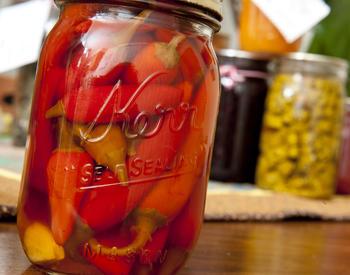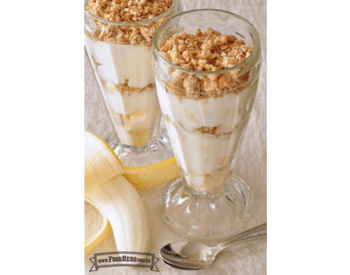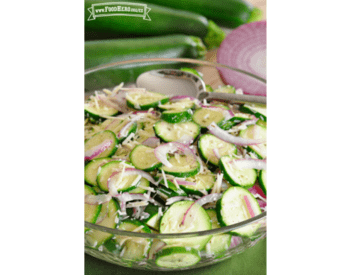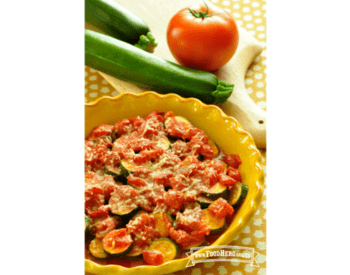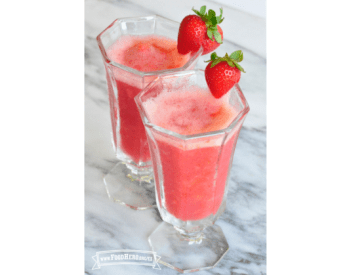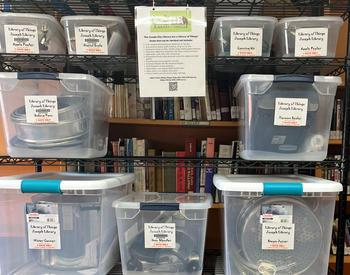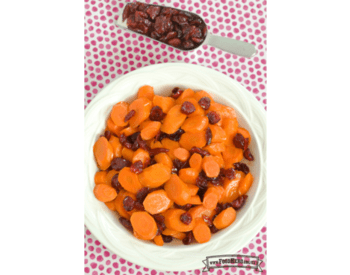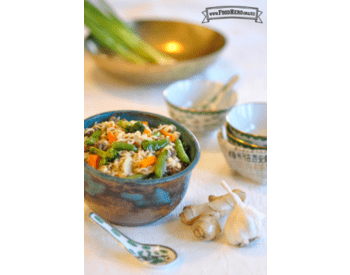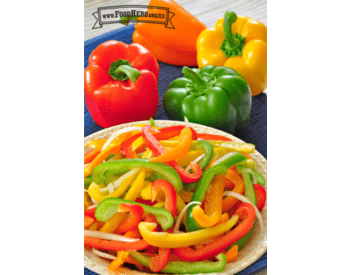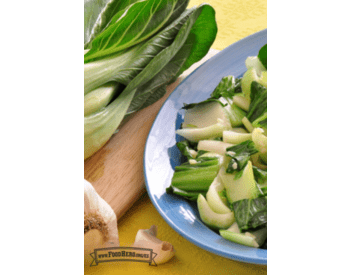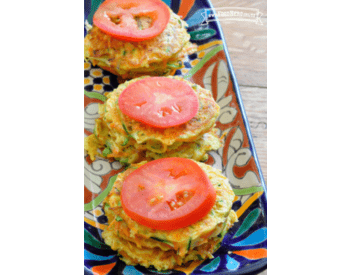Download this publication as a PDF
Dried fruits and vegetables make excellent snacks and camping food but can also add variety to family meals.
Chopping
Vegetables are usually dried in small pieces. However, fruits often need chopping before use.
- Many fruits are easy to chop if they are frozen first. While still in a frozen state, hit the fruit with a meat chopper or hammer on a wooden board. The fruit will be very brittle and break easily.
- Fruits can also be chopped in the food processor or in the blender. If they tend to gum up the blades, put a few pieces of dry bread in the blender or processor and run it.
- Dried fruits can also be cut with scissors or chopped with a knife. If they tend to stick, coat the scissors or knife with a little cooking oil.
Rehydrating
Before use in cooked dishes, dried foods need to be rehydrated. Most dried fruits and vegetables measure about one-half the volume of fresh before rehydration. Chopped or powdered dried foods measure about one-quarter the volume.
Fruits
Most dried fruit is eaten or used in recipes as is. However, you may want to plump or soften the fruit slightly to make it more chewable. You can use several methods to rehydrate your dried fruits.
- Cover the dried fruit with boiling water or fruit juice. Let stand 5–10 minutes, then drain.
- Place the dried fruit in the top of a steamer over boiling water and steam 3–5 minutes until fruit is plump.
- Sprinkle the dried fruit with fruit juice or water and let it stand several minutes.
- Cover fruit with water or fruit juice and place in the microwave. Cook until the liquid boils and then let stand 5–10 minutes to plump.
Once moisture has been returned to dried fruits, they are quite perishable and should be used soon or refrigerated.
Vegetables
Dried vegetables rehydrate more slowly than fruit because more moisture has been removed. They are usually more tender if they have been soaked long enough to reabsorb most of their lost water. If they are placed directly into a boiling soup or stew without rehydration, they will generally be tougher and chewier.
- Use only as much water as necessary to cover vegetables. Boiling water shortens the rehydration time. The water left over contains some dissolved nutrients, so keep it and use it in soups, stews or gravy.
- Rehydration may take 15 minutes to 2 hours depending on the type of vegetables, the thickness of the pieces and the temperature of the water used. Blanched vegetables take less time to rehydrate.
- Do not let the vegetables stand more than two hours in water unless you refrigerate them. Holding them at room temperature gives bacteria a chance to grow — just as it would in fresh or frozen vegetables.
Cooking
- Fruits
Dried fruit may be cooked in hot water or juice until it is tender. Soaking first, then simmering, gives a more tender fruit. Sugar and spices should be added near the end of the cooking time. - Vegetables
After rehydration, vegetables are ready to be cooked. Simmering vegetables will be more tender than those cooked at higher temperatures. If the vegetables have been rehydrated, they will cook in about the same length of time as frozen vegetables.
Add salt and other seasonings at the end of the cooking period. Dried vegetables usually don’t have the same eye appeal as fresh or frozen. They will look more like canned. You might want to dress them up a little with sauces and seasonings. They are great in soups and stews.
Recipes
Dried Fruit Crisp Dessert
- 3 cups dried fruit (apples, cherries, apricots, peaches, prunes or pears)
- 3 cups boiling water
- Topping
- ½ cup flour
- ½ cup butter or margarine
- ¾ cup brown sugar
- 1 tsp. cinnamon
- ¼ tsp. nutmeg
- ½ cup regular or quick oats
- Fruit thickening
- 1 Tbsp. cornstarch
- 1 Tbsp. sugar
Directions:
- In a large bowl, combine fruit and boiling water. Let stand at least 30 minutes to soften fruit.
- Make crumb topping by cutting butter into flour, sugar and spices. Mix in oats.
- Combine sugar and cornstarch. Mix with rehydrated fruit.
- Place fruit in a buttered 8x8x2 inch baking dish. Sprinkle on topping evenly.
- Bake 30 minutes at 350°F or until fruit bubbles and thickens and topping is golden brown.
Pear-Lemon Squares
Makes 36 1½-inch squares.
- 1 cup plus 2 Tbsp flour
- ¼ cup powdered sugar
- 2 tsp. grated lemon peel
- ¼ cup margarine
- 2 eggs
- ¾ cup sugar
- 3 Tbsp. lemon juice
- 1 tsp. baking powder
- ¼ tsp. salt
- 1 cup finely chopped dried pears
- Powdered sugar for topping
Directions:
- Grease and flour a 9-inch square baking pan; set aside.
- In a medium bowl, combine 1 cup flour, ¼ cup powdered sugar, 1 tsp. lemon peel and butter or margarine.
- With a pastry blender cut mixture until it resembles coarse cornmeal. Press mixture into bottom of prepared pan.
- Bake in preheated oven at 350°F for 15 minutes. Remove from oven.
- In a medium bowl, combine eggs and granulated sugar, beating until fluffy.
- Stir in lemon juice and remaining lemon peel.
- Add remaining 2 tbsp. flour, baking powder and salt. Mix well.
- Stir in dried pears. Pour mixture over partially baked layer and spread evenly to sides of pan.
- Bake 20 minutes until top is bubbly and very lightly browned.
- Cool before cutting into squares.
- Lightly sprinkle with powdered sugar before serving.
Variations: Other dried fruits such as apricots, apples, cherries, etc. can be used in place of pears or a combination of fruits can be used.
Apple-Pear Cookies
(This is a refrigerator cookie) Makes about 96 cookies
- Boiling water
- ¾ cup finely chopped dried apples and pears
- 1 cup butter or margarine
- 1 cup sugar
- 2 eggs
- 1 tsp. vanilla extract
- 3 cups flour
- ½ tsp. salt
- ½ tsp. baking soda
- ½ cup finely chopped nuts
Directions:
- Pour boiling water over dried fruit to cover.
- Let stand to soften 5-15 minutes; drain.
- In a medium bowl, cream butter or margarine with sugar. Add eggs and vanilla. Beat well.
- In another medium bowl, mix flour, salt, baking soda, reconstituted fruit and nuts. Add to creamed mixture and mix well.
- Shape into two 2-by-1¾-inch rolls. Wrap well in wax paper. Refrigerate 4 hours or overnight.
- Preheat oven to 400°F. Grease baking sheets.
- Cut rolls in ¼ inch slices. Place slices on prepared baking sheets.
- Bake 7-8 minutes until edges are golden. Remove from baking sheets; place on a cooling rack.
Hash Brown Potatoes
Good camping dish served with bacon and eggs.
Makes 4 servings.
- 2 cups finely diced or grated dried potatoes
- 2 tsp. dried onion flakes
- Boiling water
- 1 tsp. parsley flakes
- ½ tsp. salt
- ¼ tsp. pepper
- ¼ cup bacon drippings or vegetable oil
Directions:
- In a medium bowl, combine dried potatoes and onion flakes.
- Cover with boiling water. Let stand to reconstitute 20–30 minutes. Drain.
- Stir in parsley flakes, salt and pepper.
- In a large skillet, heat drippings or oil.
- Spread potato mixture evenly in hot skillet. Sauté slowly until underside is golden brown. Turn and brown second side.
Green Bean Casserole
- Combine in a sauce pan:
- 2 cups dried green beans
- 2½ cups boiling water
- Let stand 15–20 minutes to soften beans. Then simmer until tender, adding more water if necessary.
- Drain beans, saving liquid to use in soup or other dish.
- Combine in a buttered casserole dish:
- Drained, cooked beans
- 1 can condensed cream of mushroom soup (undiluted)
- 2 Tbsp. sliced almonds
- 2–3 Tbsp. dried mushrooms
- 2 slices of crisp fried bacon, crumbled
- Bake at 350°F for 30 minutes.
- Top with a can of french fried onions or crumbled potato chips the last 5 minutes of baking time if desired.
Vegetable Beef Soup
Makes 2 quarts
- 2 cups boiling water or beef broth
- 1 cup dried mixed vegetables
- 1 pkg. brown gravy mix
- 1 lb. ground beef
- 1 can (1 lb. 12 oz.) tomatoes
- ½ tsp. basil
- 2½ cups water or beef bouillon
- 1 tsp. salt (to taste)
- 1/3 cup long grain rice
Directions:
- Pour boiling water over dried mixed vegetables and gravy mix in a bowl. Cover bowl with plastic wrap; let stand 30 minutes to rehydrate vegetables.
- Sauté ground beef and remove excess fat. Add the undrained vegetables, the tomatoes, basil and water and salt. Heat to a boil; then cover and reduce to a simmer.
- After simmering 35 minutes, add rice.
- Cover and continue simmering another 15 minutes, just until tender.
Trail Mix
Makes approximately 4-5 cups.
½ cup each:
- Slivered or whole filberts
- Dried apples
- Dried apricots
- Dried bananas
- Dried prunes
- Flaked or shredded coconut
- Dried pears
- Dried pineapple
- Raisins
- Sunflower seeds
Cut fruit into ½ inch pieces. Combine all ingredients; mix well.
Dried Apple Pie Filling
- 3–4 cups hot water or apple juice
- 1 cup sugar
- 3 cups sliced dried apples
- 1 tsp. cinnamon
- 1 Tbsp. lemon juice
- ¼ tsp. nutmeg
- ¼ cup flour
- 2–3 Tbsp. butter or margarine (optional)
Directions:
- Heat water or apple juice to boiling. Pour over dried apples. Let stand 20–30 minutes or until apples are softened.
- Make pastry for a 2 crust 9 inch pie shell.*
- Drain apples. Add lemon juice.
- Combine dry ingredients and mix gently into apples. Pour into pie crust. Dot with butter or margarine.
- Cover with top crust, seal and flute edges. Cut decorative slits into top crust to let steam out while baking.
- Bake in preheated oven 425°F for 15 minutes. Reduce heat to 350°F and bake for 25-30 minutes.
* A recipe for pastry can be found in any basic cookbook
Scandinavian Fruit Soup
- 2 cups water
- 3–4 slices fresh lemon
- 1 small orange cut into slices
- 1 stick cinnamon
- 3 whole cloves
- 2–3 cups dried fruit (apples, apricots, pears, pineapple, cherries, plums, etc.)
- 1½ cups apple juice
- 1 cup orange juice
- 1 cup pineapple juice
- ¼–½ cup honey
- 1 Tbsp. lemon juice
- 2 Tbsp. tapioca
- Pinch of salt
- Sour cream, whipped cream or vanilla yogurt (optional)
Directions:
- In a medium saucepan, combine 2 cups water, lemon and orange slices, cinnamon stick, cloves and dried fruit. Bring to a boil.
- Remove from heat and let stand at least 30 minutes to soften fruit.
- While fruit is soaking, combine remaining ingredients (except sour cream, whipped cream or yogurt) and let stand at least 15 minutes to soften tapioca.
- Drain fruit; remove and discard cinnamon stick, cloves, lemon and orange slices.
- Add fruit to juice mixture. Bring to a boil and simmer about 15 minutes or until thickened. Serve hot or cold.
- Top serving dishes with sour cream, whipped cream or yogurt if desired.
Source: OSU Master Food Preserver Program
